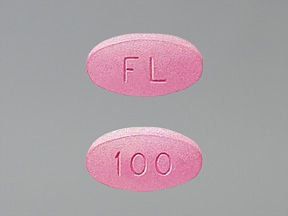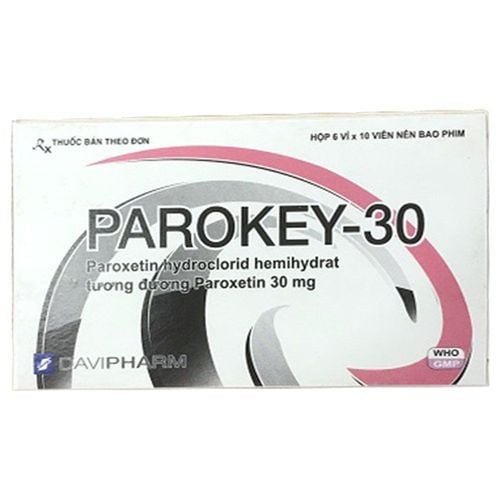This is an automatically translated article.
Paroxetine 20mg drug belongs to the group of antidepressants with the main ingredient being Paroxetine. Paroxetine 20mg is used in the treatment of depression, obsessive-compulsive disorder syndromes, panic, anxiety, post-traumatic stress disorder, premenstrual emotions and postmenopausal symptoms.
1. Uses of Paroxetine 20mg
Paroxetine 20mg belongs to the group of selective serotonin reuptake inhibitors (SSRIs), antidepressants with the main ingredient being Paroxetine. Paroxetine is a strong and highly selective inhibitor of serotonin neurons, but has very weak effects on neuronal dopamine and norepinephrine.Paroxetine 20mg is made in the form of tablets (10mg, 20mg, 30mg, 40mg), oral suspension 20mg/10ml, extended release tablets 12.5mg, 25mg and 37.5mg. Paroxetine 20mg is indicated for use in cases including: depression, obsessive-compulsive disorder, panic disorder, social anxiety disorder, anxiety disorder, post-traumatic stress disorder, premenstrual dysphoric disorder and postmenopausal symptoms.
2. How is Paroxetine 20mg used?
How to use Paroxetine 20mg: the drug is taken orally, taken whole, not broken or chewed. For extended-release tablets, do not crush the medicine. For mixed oral solution, you need to shake the medicine well before drinking. Patients should take the drug with food to limit unwanted side effects on the digestive system.
Dosage of Paroxetine 20mg in adults depends on the purpose of treatment as follows:
Depression: For the dosage form of tablets, oral suspension, the starting dose is 20mg/day and the maintenance increase is 10mg every week until when reaching a maximum dose of 50mg/day. For the extended-release dosage form, the starting dose is 25 mg/day and is maintained in 12.5 mg weekly increments until a maximum dose of 62.5 mg/day is reached. Note, do not exceed the prescribed dose and the duration of treatment in depressed patients is at least 6 months. Obsessive Compulsive Disorders: For Paroxetine 20mg tablets and oral suspension, the initial dose is 20mg/day and the maintenance dose is increased by 10mg weekly until 40mg/day, up to a maximum dose of 60mg/day. . Panic syndrome: For the tablet dosage form, oral suspension is started at 10 mg/day and maintained in 10 mg/week increments until a dose of 40 mg/day and a maximum of 60 mg/day is reached. For the extended-release dosage form, the starting dose is 12.5 mg/day and is maintained in 12.5 mg/week increments until a dose of 50 mg/day is reached, up to a maximum of 75 mg/day. Treatment lasts several months. Social phobia: For Paroxetine 20mg tablets and oral suspension, the starting dose is 20mg/day and maintained in 10mg weekly increments until a maximum dose of 60mg/day is reached. For the extended-release dosage form, the starting dose is 12.5 mg/day and is maintained in 12.5 mg weekly increments until a maximum dose of 37.5 mg/day is reached. Anxiety Disorders: For Paroxetine 20mg tablets and oral suspension, the starting dose is 20mg/day and maintained in 10mg weekly increments until a maximum dose of 50mg/day is reached. Duration of treatment for generalized anxiety disorder (GAD) minimum 8 weeks, post-traumatic stress disorder (PTSD) minimum 12 weeks. Post-traumatic stress disorder: For Paroxetine 20mg tablets and oral suspension, the starting dose is 20mg/day and maintained in 10mg weekly increments until a maximum dose of 40mg/day is reached. Premenstrual disorders: For the extended-release dosage form, the starting dose is 12.5 mg/day and the maintenance dose is increased by 12.5 mg weekly until a maximum dose of 25 mg/day is reached. Postmenopausal symptoms: 7.5mg/time/day. Dosage of Paroxetine 20mg in the elderly depends on the treatment purpose as follows:
Obsessive-compulsive disorder, social phobia, generalized anxiety disorder, post-traumatic stress disorder: For cell types Tablets and oral suspensions are administered at an initial dose of 10 mg/day and maintained in 10 mg weekly increments until a maximum dose of 40 mg/day is reached. Depression, panic syndrome: For Paroxetine 20mg tablets and oral suspension, the starting dose is 10mg/day and maintained in 10mg weekly increments until a maximum dose of 40mg/day is reached. For the extended-release tablet dosage form, the starting dose is 12.5 mg/day and is maintained in 12.5 mg weekly increments until a maximum dose of 50 mg/day is reached. Dosage of Paroxetine 20mg in patients with hepatic or renal impairment depends on the dosage form as follows:
Tablets, oral suspension: No dose adjustment is required in patients with mild to moderate hepatic/renal impairment. For patients with severe hepatic/renal impairment, the initial dose is 10 mg/day and is maintained in 10 mg weekly increments until a maximum dose of 40 mg/day is reached. Extended-release tablets: Initial dose of 12.5 mg/day and maintenance increments of 12.5 mg weekly until a maximum dose of 50 mg/day is reached in patients with mild to moderate hepatic/renal impairment and 37. 5 mg/day in patients with severe hepatic/renal impairment. Overdose of Paroxetine 20mg may cause sweating, dizziness, nausea, vomiting, dizziness, hypomania, agitation and signs of CNS excitability.
At that time, the patient needs symptomatic and supportive treatment. Pay attention to maintain respiration, heart and monitor the patient's body temperature. In case of necessity, activated charcoal and sorbitol can be used, and diazepam is used to prevent convulsions.
3. Side effects of the drug Paroxetine 20mg
Paroxetine 20mg medicine can cause some unwanted side effects with the following frequency:
Common: Fatigue, yawning, dizziness, headache, blurred vision, sweating, dry mouth, loss of appetite, nausea, constipation, diarrhea, weight gain, weakness, tremors, decreased concentration, insomnia, nightmares, anxiety, restlessness, agitation, impaired sexual function, increased cholesterol levels. Uncommon: Paroxetine 20mg rarely causes rash, pruritus, abnormal subcutaneous bleeding, hallucinations, confusion, tachycardia, hypotension when changing positions, blood pressure disorders, urinary incontinence , urinary retention, pupil dilation. Rare: Myalgia, arthralgia, peripheral edema, cholestatic jaundice, hepatitis, gastrointestinal bleeding, hyperprolactinemia, hyponatremia, thrombocytopenia, bradycardia, mania, anxiety, convulsions , dyskinesia, restless legs syndrome, gynecomastia in men, serotonin syndrome, lactation, skin rash, skin cellulite, toxic epidermal necrolysis, Stevens-Johnson syndrome. If you see any unusual symptoms when using Paroxetine 20mg, you should stop taking it and contact your doctor, pharmacist or go to a medical facility for advice and guidance on appropriate management to limit the impact on health. and life.
4. Some notes when taking Paroxetine 20mg
Do not use Paroxetine 20mg in people with hypersensitivity to the ingredients of the drug. Do not take Paroxetine 20mg at the same time as MAO inhibitors because it can cause serotonin syndrome. At least 2 weeks after stopping Paroxetine 20mg, MAO inhibitors can be started. Patients with angle-closure glaucoma need to be cautious when taking Paroxetine 20mg because it can cause pupil dilation. Do not get up suddenly while sitting or lying down because Paroxetine 20mg can cause headaches, dizziness. Elderly patients or those taking diuretics should be given the lowest starting dose of Paroxetine 20mg as it can cause hyponatremia. If the patient has symptoms of hyponatremia such as loss of concentration, headache, confusion, memory impairment, unsteadiness, the patient should stop treatment. Patients with a history of convulsions should be cautious when taking Paroxetine 20mg and if convulsions occur, the drug should be discontinued. Pregnant women should not take Paroxetine 20mg unless there is no alternative medicine and the benefits of taking the drug should be weighed against the risk of harm to the fetus. Women who are breastfeeding should not take Paroxetine 20mg or if taking the drug should not breast-feed. Limit activities that require high concentration such as driving, operating machinery because Paroxetine 20mg can cause drowsiness, reduce motor skills, thinking and judgment. The drug Paroxetine 20mg can interact with drugs: causing unwanted effects such as increased blood pressure, tremor, confusion when used with MAO drugs, Cimetidine; increased risk of bleeding when used with the anticoagulant warfarin; cause sweating, nausea, headache, dizziness when taken with Tryptophan; reduce the effect of the drug when taken together with Phenytoin and phenobarbital; cause bruising or easy bleeding when taken with an NSAID. The dose of Paroxetine 20 mg should be reduced when used with specific inhibitors of CYP2D6. Reduce the dose of procyclidine when used with paroxetine because it increases the bioavailability of procyclidine. Paroxetine also increases theophylline levels. Paroxetine 20mg drug can increase the side effects on the central nervous system when used with alcohol with manifestations such as weakness, impaired movement, thinking ability and judgment. To limit and avoid the effects of drug interactions, before taking Paroxetine 20mg, patients need to tell their doctor/pharmacist about their medical history as well as any drugs they have been using, including: prescription and non-prescription drugs, dietary supplements, herbs. The use of Paroxetine 20mg drug is to act on nerve cells to treat depression, anxiety disorders, obsessive-compulsive disorder, panic disorder, ... To ensure effective treatment And to avoid unwanted side effects, patients need to strictly follow the instructions of the doctor, professional pharmacist.
Follow Vinmec International General Hospital website to get more health, nutrition and beauty information to protect the health of yourself and your loved ones in your family.
Please dial HOTLINE for more information or register for an appointment HERE. Download MyVinmec app to make appointments faster and to manage your bookings easily.













